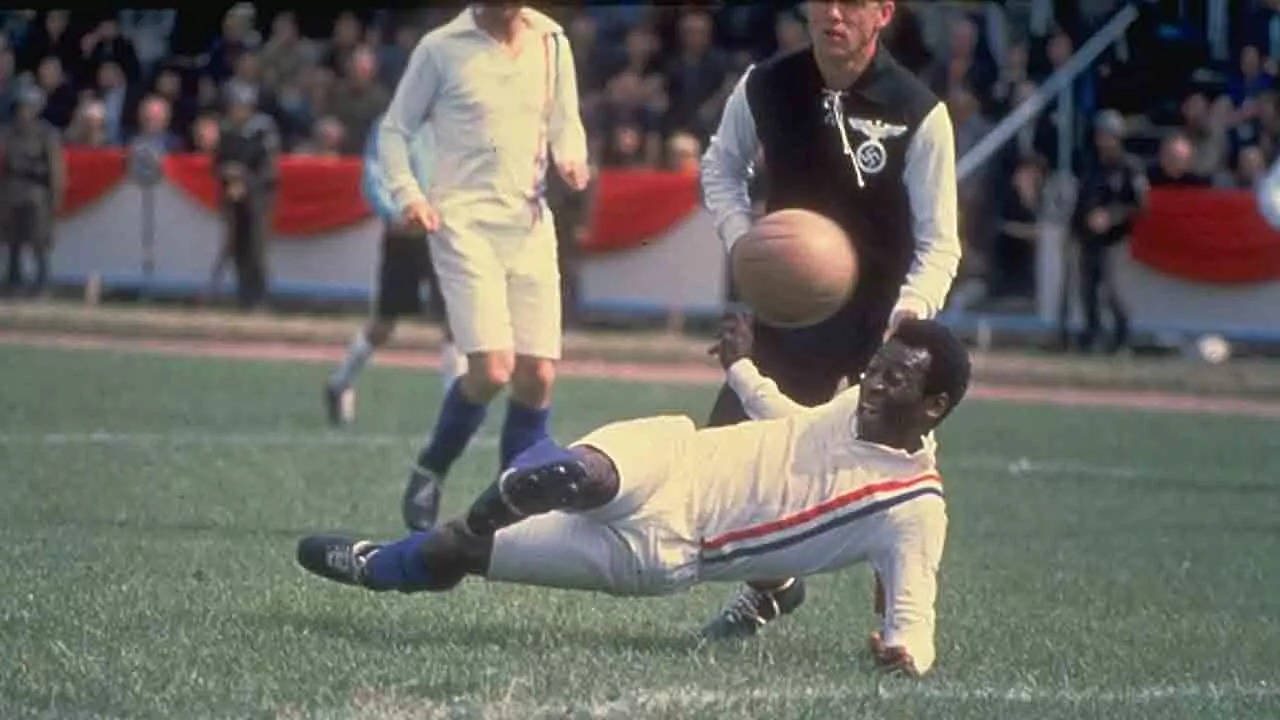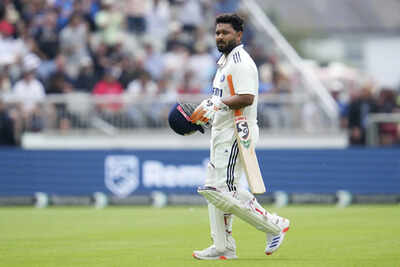PARIS: When PR Sreejesh looked through the eye-grill of his goalkeeper’s helmet, into the eyes of Maico Casella as he readied to take the penalty, the Argentine wilted under the cold stare…
Wait, did it really happen that way? Did the Indian stare because some mighty, life-altering injustice was being done to him, in sport’s overarching idea or was it just an episode in the Orwellian idea of war minus the shooting? Did Sreejesh even stare at all, because Casella actually wilted.
Maybe it was just that the mind’s eye was taking an impromptu, whimsical journey, excusing itself from the addictive rush of an India-Argentina hockey game. Because, in that moment, in one quick dash, a montage of freeze frames took one back to childhood in the 1980s, when a young kid, eyes wide, mouth agape, was believing everything the giant flickering screen was throwing at him that day. He still believes it to this day, four decades later.
There, Capt. Bob Hatch – Sylvester Stallonefor those who came in late – of the Allieds team was standing in the way of all the injustices the war, life and rigged referees dealt him at the greatest-ever imagined football match, his eyes boring into the German – then, Nazi – football captain as he prepared to take an unfairly awarded penalty.
Hatch saves the weakly-taken penalty by Baumann (played by US footballer, Werner Roth) there as Sreejesh conned Casella into pushing wide here. Justice is done, the end is the same, telling us that in war, there are no winners. Just that the Colombes stadium here – where the Indian hockey team trailing Argentina by a goal in blinding sun, is playing at the Paris Games – is the venue for that mythical football match in John Houston’s 1981, Escape to Victorythe OG of sports films, starring stars Michael CaineMax von Sydow and one, First.
Built in 1907 and named after a prodigious French rugby legend Yvesdu-Manoir – the venue in the northwestern commune of Paris, is hosting its second Olympic Games, now merely a century apart.
Today, it hosts the hockey competition. In 1924, it was the Paris Games’ premier venue, hosting the opening and closing ceremonies and athletics events. The stadium also housed the first-ever Games village – 66 men-only wooden barracks in the neighborhood. In fact, it is the real setting for another great sports movie. Dealing with antisemitism, religious prejudice and the classist idea of amateurs and professionals in sports, the four-Oscar winner Chariots of Fire (also released in 1981) speaks about the rivalry between British runners, Harold Abrahams, a Jew and a devout Scottish Chirstian, Eric Liddell.
It has its final operatic flourish in the 100m at the Yves-du-Manoir, which Abrahams wins after Liddell pulls out since the 100m heats falls on a Sunday, the Lord’s Day.
In between these two Olympics, the Yves-du-Manoir also hosted perhaps the greatest fictional football match ever, though Wikipedia tells us that “the now demolished MTK Stadium in Budapest,” stood in for the Colombes Stadium in Paris. In “Escape to…”, Paris is chosen as the venue for the match since it is the closest acceptable neutral venue on gentle insistence of the Allied Prisoners of War, whose main aim is to try to escape under the distraction of a propaganda football match.
Called Stade Olympique Yves-duManoir during the war, you can see why Colombes would be an interesting setting for the climax of a World War II film. Today, nestled around the stadium complex, standing among the towers of social housing are homes from the 1940s with their distinct tiled sloping roofs, small front lawns and red-bricked chimney towers. An old 1940s stone building adorns the entrance of the stadium, its contrast with the modern-day trappings and scaffolding standing out.
“This is one of the first suburbs of Paris,” says Catherine Simonnet, a Britisher from Essex who has been living in France for the past 25 years. “It used to be promising once, now it’s neither here, nor there, somewhat lost in time,” she explains, pointing to the social housing that she says came up in the last decade or so. The chief demographic remains the original native French who moved out of the centre of Paris as the city expanded in the post-War years. Today, you can see a fair smattering of African and south Asian immigrants in the area, an indication of the heavy Indian support at the hockey games.
Colombes, seemingly exhumed from obscurity for Paris 2024 for hockey, is run by the Hauts de Seine department, with rugby being the main sport here today. The Hauts de Seine press office will only answer in French and will not entertain calls on the weekend. An email sent to their office for more details on the locality’s history is still to receive an answer.
Meanwhile, Simonnet, whose daughter plays hockey, excitedly tells you that following the revival, this is to become a base for the development of the game, and the headquarters for the French federation.
Home of the football club Racing CFF, Colombes has an interesting place in French football. It was the country’s premier football ground in the years straddling the wars, till the Parc de Princes came up in 1972. Today, the Parc adjoining the Roland Garros is the home of Paris Saint Germain, having relinquished its position to 80,000-seater Stade de France in SaintDenis in Paris’s north commune.
In the march of time, obscurity is the fate of buildings and monuments, but the Colombes has enjoyed a much storied life. In this Olympic year, it is learning to live, and relive again.
Wait, did it really happen that way? Did the Indian stare because some mighty, life-altering injustice was being done to him, in sport’s overarching idea or was it just an episode in the Orwellian idea of war minus the shooting? Did Sreejesh even stare at all, because Casella actually wilted.
Maybe it was just that the mind’s eye was taking an impromptu, whimsical journey, excusing itself from the addictive rush of an India-Argentina hockey game. Because, in that moment, in one quick dash, a montage of freeze frames took one back to childhood in the 1980s, when a young kid, eyes wide, mouth agape, was believing everything the giant flickering screen was throwing at him that day. He still believes it to this day, four decades later.
There, Capt. Bob Hatch – Sylvester Stallonefor those who came in late – of the Allieds team was standing in the way of all the injustices the war, life and rigged referees dealt him at the greatest-ever imagined football match, his eyes boring into the German – then, Nazi – football captain as he prepared to take an unfairly awarded penalty.
Hatch saves the weakly-taken penalty by Baumann (played by US footballer, Werner Roth) there as Sreejesh conned Casella into pushing wide here. Justice is done, the end is the same, telling us that in war, there are no winners. Just that the Colombes stadium here – where the Indian hockey team trailing Argentina by a goal in blinding sun, is playing at the Paris Games – is the venue for that mythical football match in John Houston’s 1981, Escape to Victorythe OG of sports films, starring stars Michael CaineMax von Sydow and one, First.
Built in 1907 and named after a prodigious French rugby legend Yvesdu-Manoir – the venue in the northwestern commune of Paris, is hosting its second Olympic Games, now merely a century apart.
Today, it hosts the hockey competition. In 1924, it was the Paris Games’ premier venue, hosting the opening and closing ceremonies and athletics events. The stadium also housed the first-ever Games village – 66 men-only wooden barracks in the neighborhood. In fact, it is the real setting for another great sports movie. Dealing with antisemitism, religious prejudice and the classist idea of amateurs and professionals in sports, the four-Oscar winner Chariots of Fire (also released in 1981) speaks about the rivalry between British runners, Harold Abrahams, a Jew and a devout Scottish Chirstian, Eric Liddell.
It has its final operatic flourish in the 100m at the Yves-du-Manoir, which Abrahams wins after Liddell pulls out since the 100m heats falls on a Sunday, the Lord’s Day.
In between these two Olympics, the Yves-du-Manoir also hosted perhaps the greatest fictional football match ever, though Wikipedia tells us that “the now demolished MTK Stadium in Budapest,” stood in for the Colombes Stadium in Paris. In “Escape to…”, Paris is chosen as the venue for the match since it is the closest acceptable neutral venue on gentle insistence of the Allied Prisoners of War, whose main aim is to try to escape under the distraction of a propaganda football match.
Called Stade Olympique Yves-duManoir during the war, you can see why Colombes would be an interesting setting for the climax of a World War II film. Today, nestled around the stadium complex, standing among the towers of social housing are homes from the 1940s with their distinct tiled sloping roofs, small front lawns and red-bricked chimney towers. An old 1940s stone building adorns the entrance of the stadium, its contrast with the modern-day trappings and scaffolding standing out.
“This is one of the first suburbs of Paris,” says Catherine Simonnet, a Britisher from Essex who has been living in France for the past 25 years. “It used to be promising once, now it’s neither here, nor there, somewhat lost in time,” she explains, pointing to the social housing that she says came up in the last decade or so. The chief demographic remains the original native French who moved out of the centre of Paris as the city expanded in the post-War years. Today, you can see a fair smattering of African and south Asian immigrants in the area, an indication of the heavy Indian support at the hockey games.
Colombes, seemingly exhumed from obscurity for Paris 2024 for hockey, is run by the Hauts de Seine department, with rugby being the main sport here today. The Hauts de Seine press office will only answer in French and will not entertain calls on the weekend. An email sent to their office for more details on the locality’s history is still to receive an answer.
Meanwhile, Simonnet, whose daughter plays hockey, excitedly tells you that following the revival, this is to become a base for the development of the game, and the headquarters for the French federation.
Home of the football club Racing CFF, Colombes has an interesting place in French football. It was the country’s premier football ground in the years straddling the wars, till the Parc de Princes came up in 1972. Today, the Parc adjoining the Roland Garros is the home of Paris Saint Germain, having relinquished its position to 80,000-seater Stade de France in SaintDenis in Paris’s north commune.
In the march of time, obscurity is the fate of buildings and monuments, but the Colombes has enjoyed a much storied life. In this Olympic year, it is learning to live, and relive again.








